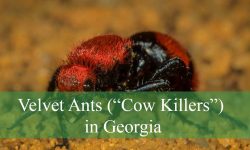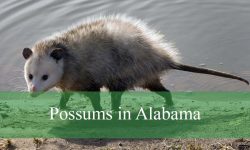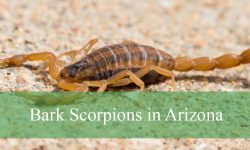Centipedes are fascinating arthropods that thrive in Arkansas’s diverse ecosystems. From moist forests to garden soils, these predators play an important role in controlling insects and other small invertebrates.
While their many legs and quick movements can seem intimidating, most centipede species found in Arkansas are harmless to humans. They prefer hiding under logs, rocks, leaf litter, and even in damp indoor spaces like basements and bathrooms.
This guide highlights 7 types of centipedes in Arkansas, providing detailed identification tips, habitat information, and behavior notes. Nature enthusiasts and curious observers alike can use this guide to recognize these unique creatures safely.
Different Types of Centipedes Found in Arkansas
Giant Redheaded Centipede (Scolopendra heros)

The Giant Redheaded Centipede is North America’s largest centipede, easily recognized by its striking reddish-orange head and dark body. Adult specimens can grow up to 8 inches in length, making them a formidable presence in the wild. Their segmented bodies are robust and flexible, allowing them to move quickly and capture prey efficiently. The yellowish legs provide a stark contrast to the dark body segments, adding to their distinctive appearance.
These centipedes are primarily nocturnal predators. They hunt insects, spiders, and occasionally small vertebrates such as lizards or rodents. Using venomous forcipules (modified front legs), they can immobilize prey instantly. Despite their intimidating size, their bites are rarely life-threatening to humans, though they can cause localized pain and swelling.
Habitat preferences include moist wooded areas, under rocks, logs, and leaf litter. They are often found in areas with dense vegetation that provides cover during the day. This environment also supports a steady supply of prey, making it ideal for their survival. In Arkansas, they are most commonly observed in the northern and central parts of the state.
Reproduction occurs in the warmer months, with females laying dozens of eggs in protected soil cavities or under logs. The female guards the eggs until they hatch, displaying parental care uncommon among arthropods. Juveniles resemble small adults and undergo multiple molts as they grow, eventually reaching full size over one to two years.
Eastern Bark Centipede (Hemiscolopendra marginata)
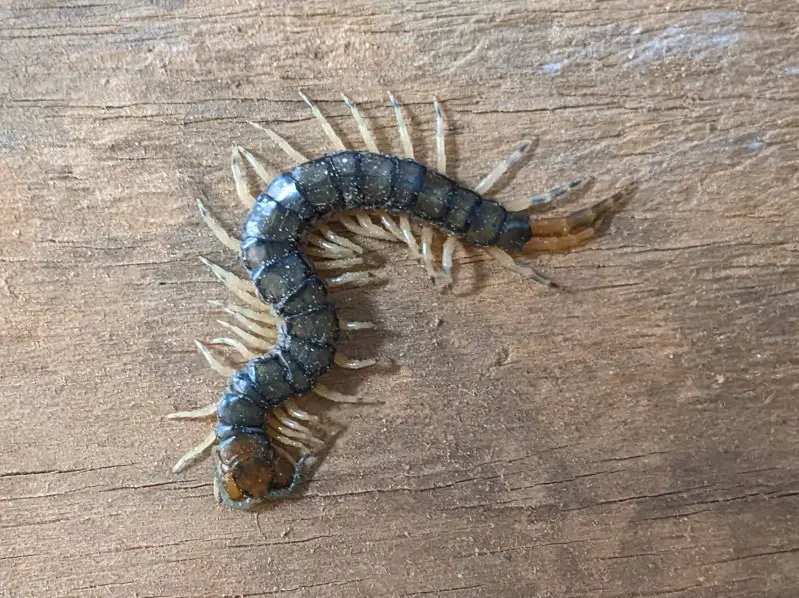
The Eastern Bark Centipede is medium-sized, with an olive-green or brown body adorned with black-edged segments and a thin black stripe running along its back. Legs and antennae are pale yellow, giving it a somewhat delicate appearance compared to larger centipedes. Adults typically range from 3 to 5 inches in length, and their flattened bodies allow them to navigate narrow spaces under bark and debris.
These centipedes are also nocturnal and skilled hunters. Their diet consists mainly of insects and small invertebrates. They use venomous forcipules to subdue prey, which makes them efficient predators despite their smaller size. Observing them hunting at night reveals their swift and precise movements, as they actively track down prey along tree trunks or under decaying wood.
Eastern Bark Centipedes are primarily found in forests with ample bark and leaf litter. They thrive in humid conditions that prevent desiccation and often shelter under loose bark, stones, or fallen logs during the day. This microhabitat not only offers protection from predators but also maintains a stable moisture level essential for survival.
Reproduction in this species involves females laying eggs in protected locations within the bark or soil. Females display some degree of parental care by guarding the eggs until they hatch. Juveniles undergo multiple molts to reach adulthood, and both males and females are venomous, although males typically have a slightly different venom composition.
House Centipede (Scutigera coleoptrata)
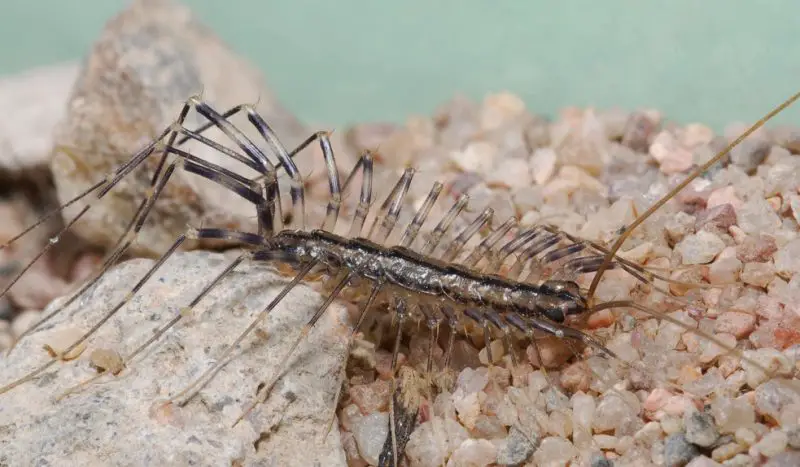
The House Centipede is easily identified by its extremely long, slender legs and fast, jerky movements. The body is pale yellow to gray with three dark dorsal stripes running lengthwise, giving it a striped appearance. Adults measure 1 to 1.5 inches, but the long legs make them appear larger. Their delicate structure allows them to move quickly across walls, floors, and ceilings inside homes.
House Centipedes are adapted to human environments, often residing in basements, bathrooms, and crawlspaces. They are nocturnal hunters, feeding on common household pests like cockroaches, flies, spiders, and silverfish. Their speed and agility make them effective natural pest controllers, reducing populations of other insects indoors.
Despite their alarming appearance, they pose minimal risk to humans. Bites are rare and usually result in minor pain similar to a bee sting. The centipede’s primary defense mechanism is to flee quickly rather than attack. Their presence in a home is generally beneficial because they prey on other nuisance insects.
House Centipedes reproduce year-round in favorable indoor conditions. Females lay small clusters of eggs in damp, protected areas, and juveniles resemble miniature adults. As they molt and grow, their leg count increases until they reach the characteristic number of 15 pairs of long legs. Proper moisture control and sealing of cracks can help manage indoor populations.
Brown Centipede (Lithobius forficatus)

The Brown Centipede is a small to medium-sized species, typically measuring 18–30 mm in length. Its dark reddish-brown, chestnut-colored body is segmented with each segment bearing a pair of legs, giving it a distinct appearance. The centipede’s flattened body allows it to navigate tight spaces under rocks, leaf litter, and decaying wood efficiently. Its antennae are long and sensitive, helping detect prey and environmental cues.
This species is nocturnal and highly predatory, feeding on slugs, worms, spiders, and flies. Its forcipules deliver venom to subdue prey, though this venom is generally harmless to humans. Observing the Brown Centipede at night reveals its rapid hunting behavior, carefully stalking small invertebrates before striking with precision.
The Brown Centipede prefers moist habitats, including gardens, forests, and areas with abundant organic debris. During the day, it hides in damp soil or under objects to avoid desiccation and predators. In Arkansas, it is widely distributed and commonly found in both rural and suburban areas with adequate moisture.
Reproduction occurs with females laying eggs in soil or protected areas. Juveniles hatch resembling smaller adults and undergo multiple molts, gradually increasing in size and leg count. This species contributes to natural pest control by regulating populations of smaller invertebrates in its ecosystem.
Pitted Soil Centipede (Geophilus mordax)
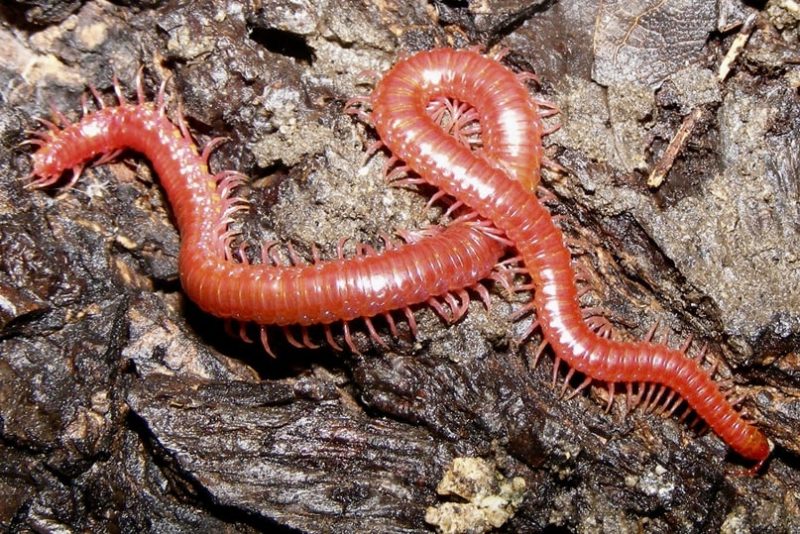
The Pitted Soil Centipede is a bright red soil-dwelling species, growing up to 50 mm in length. Its elongated, cylindrical body is segmented with numerous legs—49–53 pairs in males and 49–57 in females. Its coloration helps distinguish it from other soil centipedes in Arkansas. The centipede moves slowly compared to surface predators but is highly effective in hunting underground prey.
Geophilus mordax primarily inhabits moist, decaying organic matter in soil, including leaf litter and compost piles. This species feeds on small invertebrates such as insects, larvae, and worms, playing a crucial role in soil ecosystems by controlling populations and aiding in decomposition.
This centipede is rarely seen on the surface as it prefers to remain underground, maintaining moisture and protection from predators. Its presence often indicates healthy soil rich in organic material. They are widespread across Arkansas wherever suitable soil and moisture conditions exist.
Reproduction involves females laying eggs in burrows or protected soil crevices. The young emerge resembling tiny adults and gradually grow by molting multiple times. Geophilus mordax is relatively harmless to humans and contributes to the balance of invertebrate populations in its habitat.
Geophilus okolonae

Geophilus okolonae is a soil-dwelling centipede native to Arkansas, reaching up to 40 mm in length. Males typically have 61 pairs of legs, while females have 63 pairs, giving it a distinctive leg count compared to other local centipedes. Its elongated, pale yellow to brown body allows it to navigate soil and leaf litter efficiently. Unlike some related species, it lacks coxal pores, a key identifying feature.
This species inhabits moist soil environments, often found in gardens, forests, and other areas rich in decaying organic matter. It remains mostly hidden during the day, emerging at night to hunt small soil invertebrates. Its feeding behavior is critical for maintaining soil health and invertebrate balance.
Geophilus okolonae’s distribution in Arkansas is mainly localized around Okolona and similar habitats. It is rarely seen outside its preferred moist soil environment, and it avoids surface exposure to prevent dehydration. Its presence is an indicator of fertile, well-aerated soil.
Reproduction is similar to other soil centipedes, with females laying eggs in soil and guarding them until they hatch. Juveniles resemble miniature adults and gradually grow with successive molts. This centipede is non-aggressive and poses no danger to humans, making it an important ecological species in Arkansas soil ecosystems.
Marsikomerus Species
The Marsikomerus genus includes several small soil centipedes present in Arkansas, such as M. arcanus and M. texanus. They range from 1 to 5 cm in length and have 39–61 pairs of legs depending on the species. Their bodies are slender and pale, allowing them to easily move through soil and leaf litter. The legs are relatively short, giving them a segmented, flexible appearance ideal for underground navigation.
Marsikomerus centipedes are nocturnal predators, feeding on tiny soil invertebrates like insect larvae and worms. They rely on their sensitive antennae to detect prey in dark, confined spaces. Their venom is sufficient to immobilize small prey but is harmless to humans.
These species prefer moist habitats such as under logs, rocks, and in soil rich with organic material. Their survival depends on maintaining a humid microenvironment, as they are prone to desiccation. Marsikomerus species are widely distributed across Arkansas in both forested and semi-rural areas.
Reproduction involves females laying eggs in moist soil, with juveniles resembling small adults. They molt multiple times before reaching maturity, gradually increasing in size and leg count. Marsikomerus centipedes play an important ecological role in decomposing organic matter and regulating small invertebrate populations.
Tips for Managing Centipedes in Arkansas
Centipedes are naturally drawn to damp environments, so moisture control is one of the most effective ways to reduce their presence. Keeping basements, bathrooms, and crawlspaces dry with dehumidifiers or proper ventilation can make these areas less appealing. Repairing leaks in plumbing and ensuring gutters and downspouts direct water away from your home also helps minimize moisture that attracts centipedes.
Another important strategy is to seal entry points around your home. Check for gaps around doors, windows, and foundation cracks where centipedes might enter. Weatherstripping, caulking, and installing door sweeps can create an effective barrier, reducing the chances of indoor invasions. Even small openings can serve as entryways, so a thorough inspection is key.
Removing debris from around your property can further discourage centipedes. Leaf litter, mulch, wood piles, and stones create ideal habitats where centipedes can hide and hunt. Keeping yards tidy and storing firewood away from the house not only limits potential shelter but also reduces prey populations that attract centipedes.
For more serious infestations, professional pest control may be necessary. Pest control experts can identify the specific centipede species, assess the severity of the infestation, and implement targeted treatments. Combining professional guidance with good moisture management, sealing, and debris removal provides the most effective long-term control.
FAQs About Centipedes in Arkansas
What types of centipedes are found in Arkansas?
Arkansas hosts a variety of centipede species, including the Giant Redheaded Centipede (Scolopendra heros), Eastern Bark Centipede (Hemiscolopendra marginata), House Centipede (Scutigera coleoptrata), Brown Centipede (Lithobius forficatus), Pitted Soil Centipede (Geophilus mordax), Geophilus okolonae, and several Marsikomerus species. These species vary in size, habitat preference, and behavior.
Are centipedes dangerous to humans in Arkansas?
Most centipedes in Arkansas are not dangerous to humans. Larger species like the Giant Redheaded Centipede can deliver a painful bite, but it is rarely life-threatening. Smaller species, such as the House Centipede or soil centipedes, pose minimal risk. Bites may cause temporary pain, swelling, or irritation, but medical attention is rarely required.
Where are centipedes commonly found in Arkansas?
Centipedes are found in both outdoor and indoor environments. Outdoor habitats include forests, leaf litter, under logs, rocks, and moist soil, while indoor species, like the House Centipede, prefer basements, bathrooms, and crawlspaces. Moist, humid areas provide ideal conditions for most species.
How can I prevent centipedes from entering my home?
Preventive measures include controlling moisture with dehumidifiers, sealing cracks and gaps around doors and windows, and removing debris such as mulch, leaf litter, and wood piles near your home. Maintaining a clean, dry, and well-sealed environment reduces the likelihood of indoor centipede infestations.
Do centipedes help with pest control?
Yes. Centipedes are natural predators that feed on insects, spiders, and other small invertebrates. House Centipedes, for example, prey on cockroaches, flies, and silverfish indoors, while outdoor species help control soil and forest-dwelling invertebrate populations.
When are centipedes most active in Arkansas?
Centipedes are primarily nocturnal, meaning they are most active at night. Outdoor species hunt at night, hiding during the day under debris or in soil. Indoor species like the House Centipede may be spotted in bathrooms, basements, or kitchens during the evening or nighttime hours.
Should I call a professional if I find centipedes?
If you encounter only a few centipedes, simple measures like moisture control and sealing entry points may suffice. For significant infestations, consulting professional pest control services is recommended. Experts can identify species, assess severity, and apply targeted treatments for effective management.

